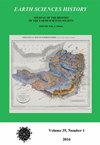MINING, ALCHEMY, AND THE CHANGING CONCEPT OF MINERALS FROM ANTIQUITY TO EARLY MODERNITY
IF 0.3
4区 哲学
Q4 GEOSCIENCES, MULTIDISCIPLINARY
引用次数: 1
Abstract
This paper analyzes how the Western concept of minerals evolved over time. Greco-Roman philosophers saw minerals as a form of plant that yielded useful metals or medicines. Most of their data came from mines and focused on ore minerals, but medicinal uses were more highly regarded and were the principal intentional focus of early mineral literature. As mining waned in the early medieval period, the focus of mineral literature shifted to emphasize gemstones rather than ores and mysticism rather than metallurgy, while medicine continued to be prominent. Descriptions from firsthand observation became rare. Starting in the 9th century AD, an inorganic concept of minerals as chemicals began to arise from alchemical experiments in the Middle East. The alchemical mineral literature demonstrated that minerals differed from plants in being separable into constituent ingredients by chemical processes, focusing on ores. The sulfur-mercury model of mineral origin also reflects a strong emphasis on metal ores at the expense of other minerals. As mining rates increased again in Europe after the 10th century, this alchemical concept of minerals caught on. However, the alchemical model acquired a spiritual gloss, leading to a divide in the 16th century between a spiritualized organic model of minerals and an inorganic or mechanical alternative, both focused mainly on ores. Eventually the concept of spiritual or living minerals diverged from the mineral to the alchemical literature in the 16th century, as the mechanical model evolved into the modern chemical identification of minerals.采矿,炼金术,以及从古代到现代早期矿物概念的变化
本文分析了西方矿物概念的演变过程。希腊罗马哲学家认为矿物是一种植物,可以产生有用的金属或药物。他们的大多数数据来自矿山,集中在矿石矿物上,但药用用途更受重视,是早期矿物文献的主要目的。随着中世纪早期采矿业的衰落,矿物文学的重点转移到强调宝石而不是矿石和神秘主义而不是冶金,而医学继续占据突出地位。来自第一手观察的描述变得罕见。从公元9世纪开始,在中东的炼金术实验中,矿物作为化学物质的无机概念开始出现。炼金术矿物文献表明,矿物不同于植物,可以通过化学过程分离成组成成分,重点是矿石。关于矿物来源的硫汞模型也反映出以牺牲其他矿物为代价而强烈强调金属矿石。10世纪以后,随着欧洲开采率的再次提高,矿物的炼金术概念开始流行起来。然而,炼金术模型获得了精神上的光泽,导致了16世纪矿物的精神化有机模型和无机或机械替代模型之间的分歧,两者都主要关注矿石。最终,精神矿物或活矿物的概念在16世纪从矿物分化到炼金术文献,因为机械模型演变成现代矿物的化学鉴定。
本文章由计算机程序翻译,如有差异,请以英文原文为准。
求助全文
约1分钟内获得全文
求助全文
来源期刊

Earth Sciences History
GEOSCIENCES, MULTIDISCIPLINARY-HISTORY & PHILOSOPHY OF SCIENCE
CiteScore
1.00
自引率
0.00%
发文量
1
审稿时长
>12 weeks
期刊介绍:
Earth Sciences History promotes and publishes historical work on all areas of the earth sciences – including geology, geography, geophysics, oceanography, paleontology, meteorology, and climatology.
The journal honors and encourages a variety of approaches to historical study: biography, history of ideas, social history, and histories of institutions, organizations, and techniques.
Articles are peer reviewed.
 求助内容:
求助内容: 应助结果提醒方式:
应助结果提醒方式:


